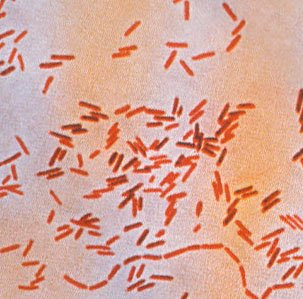 Typhoid fever, also known as enteric fever, or commonly just typhoid, is an illness caused by the bacterium Salmonella enterica serovar Typhi. Common worldwide, it is transmitted by the ingestion of food or water contaminated with feces from an infected person. The bacteria then perforate through the intestinal wall and are engulfed by macrophages. Salmonella Typhi then alters its structure to resist destruction and allow them to exist within the macrophage. This renders them resistant to damage by PMN's (Polymorphonuclear Leukocytes), complement and the immune response. The organism is then spread via the lymphatics while inside the macrophages. This gives them access to the reticuloendothelial system and then to the different organs throughout the body. The organism is a Gram-negative short bacillus that is motile due to its peritrichous flagella. The bacteria grows best at 37 °C/99 °F – human body temperature.
Typhoid fever, also known as enteric fever, or commonly just typhoid, is an illness caused by the bacterium Salmonella enterica serovar Typhi. Common worldwide, it is transmitted by the ingestion of food or water contaminated with feces from an infected person. The bacteria then perforate through the intestinal wall and are engulfed by macrophages. Salmonella Typhi then alters its structure to resist destruction and allow them to exist within the macrophage. This renders them resistant to damage by PMN's (Polymorphonuclear Leukocytes), complement and the immune response. The organism is then spread via the lymphatics while inside the macrophages. This gives them access to the reticuloendothelial system and then to the different organs throughout the body. The organism is a Gram-negative short bacillus that is motile due to its peritrichous flagella. The bacteria grows best at 37 °C/99 °F – human body temperature.Typhoid fever is characterized by a sustained fever as high as 40 °C (104 °F), profuse sweating, gastroenteritis, and non-bloody diarrhea. Less commonly a rash of flat, rose-colored spots may appear.
Classically, the course of untreated typhoid fever is divided into four individual stages, each lasting approximately one week. In the first week, there is a slowly rising temperature with relative bradycardia, malaise, headache and cough. A bloody nose (epistaxis) is seen in a quarter of cases and abdominal pain is also possible. There is leukopenia, a decrease in the number of circulating white blood cells, with eosinopenia and relative lymphocytosis, a positive diazo reaction and blood cultures are positive for Salmonella Typhi or Paratyphi. The classic Widal test is negative in the first week.
In the second week of the infection, the patient lies prostrated with high fever in plateau around 40 °C (104 °F) and bradycardia (Sphygmo-thermic dissociation), classically with a dicrotic pulse wave. Delirium is frequent, frequently calm, but sometimes agitated. This delirium gives to typhoid the nickname of "nervous fever". Rose spots appear on the lower chest and abdomen in around 1/3 patients. There are rhonchi in lung bases. The abdomen is distended and painful in the right lower quadrant where borborygmi can be heard. Diarrhea can occur in this stage: six to eight stools in a day, green with a characteristic smell, comparable to pea-soup. However, constipation is also frequent. The spleen and liver are enlarged (hepatosplenomegaly) and tender and there is elevation of liver transaminases. The Widal reaction is strongly positive with antiO and antiH antibodies. Blood cultures are sometimes still positive at this stage.
In the third week of typhoid fever a number of complications can occur: Intestinal hemorrhage due to bleeding in congested Peyer's patches; this can be very serious but is usually non-fatal. Intestinal perforation in distal ileum: this is a very serious complication and is frequently fatal. It may occur without alarming symptoms until septicemia or diffuse peritonitis sets in. Encephalitis, metastatic abscesses, cholecystitis, endocarditis and osteitis may also occur. The fever is still very high and oscillates very little over 24 hours. Dehydration ensues and the patient is delirious (typhoid state). By the end of third week the fever has started reducing (defervescence). This carries on into the fourth and final week.
[External Links]
Information from WHO
Information from MedlinePlus
Information from medicinenet.com
Information from eMedicine




No comments:
Post a Comment